Why Choose Hardwood Flooring?
When it comes to flooring options, the world is your oyster. You can select from vinyl, luxury vinyl, laminate, stone, tile, concrete, and hardwood flooring. So, why choose wood flooring with all these other types of flooring available?
October 13, 2022 | By Bruce Product Expert
Hardwood Flooring Through the Years
Wood flooring dates to the early 1600s. It was prevalent in the Baroque Era, ranging from 1625 to 1714. During that time, the French introduced intricate patterns featuring parquetry and marquetry.
Then, taking advantage of heavily forested North America, American colonists used random-width, wide plank wood flooring. They typically left the floors unfinished and exposed to natural wear.
The Victorian period from 1840 through 1910 saw parquet wood floors appear in wealthy homes. During this period, manufacturers also began to produce wood floors on a mass scale.
Wood Flooring Takes on the Look of Today
Tongue and groove wood flooring entered the scene in the early 1900s. It created a polished, uniform look that paved the way for wood flooring as we know it today. Herringbone patterns began to capture the imagination of consumers.
Wood flooring declined in popularity starting in the 1920s owing to the introduction of linoleum and cork floors. And shortly after that, carpeting entered the market and became the mainstay flooring choice, primarily because of its lower cost.
Well, history repeats itself, as they say, and starting in the 1980s, wood flooring saw a resurgence that has continued to this day. Prefinished floors provided homeowners with a ready-made way to install hardwood floors. Homeowners no longer had to plan and allow for the multiple days required to stain and apply a finish to get a beautiful, finished product. And wood flooring is more durable than ever thanks to advances in manufacturing.
So, history may provide insight into why you might choose wood flooring. But let’s consider why homeowners prefer hardwood flooring over other types in the 21st century.
Wood Floors Have Timeless Appeal
Types of flooring like carpet, linoleum, and tile come and go. For example, many homeowners today rip out carpeting to expose wood flooring and bring it back to life. Wood flooring was in style in America’s pioneer days and remains in style 200-plus years later.
Hardwood floors take us back. But, at the same time, they give you various options to create your style. You can select from multiple types of hardwood flooring featuring wood species like red oak, hickory, maple, or cherry. In case you’re curious, oak flooring is America’s favorite.
You can even look at exotic species like teak, mahogany, or Brazilian Cherry. Each species presents its own unique wood grain pattern and color.
In addition, wood flooring is versatile. It adapts to almost any design theme in your home without clashing. For example, you can go with a smooth look and thin planks. Or get more rustic with wider planks that incorporate a distressed look.
Solid Hardwood Floors Last
Some of the aforementioned Baroque period wood flooring remains today, almost 400 years later. In addition, many homes from the 1700s and 1800s boast original wood.
Solid wood floors handle everyday wear and tear. Even scratches and minor blemishes don’t detract from their beauty. On the contrary, they only add more character.
Plus, today’s prefinished hardwood floors offer more substantial durability. Their finishes penetrate the wood to protect against scratches and dents. In addition, you can hide blemishes by selecting wood floors with a hand-scraped finish.
Hardwood floors add warmth to your home, both figuratively and realistically. For instance, manufactured floors like laminates, ceramic tiles, or stone floors are cold underfoot, especially in colder months. However, wood floors retain their warmth. So, you’re less prone to step out of bed and have your feet hit a cold floor.
Wood floors also improve acoustics. For example, you won’t experience a hollow sound or vibrations from a properly installed solid hardwood floor.
Hardwood Flooring is Sustainable and Eco-Friendly
Wood flooring is a sustainable and eco-friendly solution. But it’s essential to understand these terms aren’t the same. Sustainability addresses the ability to maintain a product or process over time without depleting natural resources.
Wood flooring sustainability focuses on the ability to produce products without contributing to deforestation. However, eco-friendly focuses on environmental damage caused by the manufacturer of the product.
As manufacturers harvest trees, they can plant new trees for regrowth. And that process helps retain forests and tree populations. So, the harvesting of trees won’t impact future generations.
In addition, reclaimed hardwood promotes sustainability. As older structures’ flooring is dismantled, it becomes wood flooring.
Engineered Hardwood Floors Are Equally Sustainable
Engineered hardwood floors also encourage sustainable flooring. Engineered wood floors use a top layer of real hardwood. So, less solid hardwood is required to make the finished product.
Moreover, reputable wood flooring manufacturers support the U.S. Forest Stewardship Council (FSC). Its goal is to ensure forest preservation practices and afforestation. So when purchasing solid wood flooring and engineered hardwood, look for products having FSC approval.
Eco-Friendly Flooring
Eco-friendly focuses on environmental damage caused by the manufacturer of the product. So products and manufacturing processes that pollute the air or consume fossil fuels may be considered less eco-friendly.
The term also pertains to products that generate waste in landfills. For example, vinyl flooring typically winds up in landfills once removed whereas reclaimed hardwood (when older structures’ flooring is dismantled), can be reused in a new or refurbished structure.
Eco-friendly also takes into account the toxicity of flooring, including the adhesives and finishes. Flooring high in volatile organic compounds (VOCs) is also a focus.
As mentioned, FSC governs sustainability. However, other bodies like Greenguard Gold, Indoor Air Advantage Gold, and CARB2 focus on standards for eco-friendly flooring.
Hardwood Floors Improve Your Home’s Hygiene
Carpets trap dust, animal dander, parasites, spores, odors, and other concerns that impact your family’s hygiene. And that’s especially true if you have allergy sufferers in your family.
On the other hand, wood floors do not trap dust or dander. In fact, these types of pollutants can be easily wiped away. In addition, hardwood won’t harbor orders from pets or spills, providing you clean your hardwood flooring after an incident.
So, if you care about your family’s health, wood floors are worth the price.
Wood Floors Represent an Investment
There’s no question hardwood flooring costs more than other types of flooring. But it provides a return on your investment.
First, most people in today’s market prefer solid wood floors, which increases your resale value infinitely more than carpeting. Moreover, you might even sell your home faster with wood flooring.
Second, most wood flooring can be sanded and refinished to extend its life. For example, if your floors show excessive wear and tear, you can sand them to remove the blemishes. Then, you refinish the floors to make them brand new.
You Can Refinish Your Hardwood Floors to Extend Their Life
Equally important, solid wood flooring allows you to go through this process multiple times. So, if someone tells you wood floors can last you a lifetime, they aren’t kidding. You can easily extend the lifetime of your hardwood to 100 years or more.
Good luck doing that with vinyl flooring, luxury vinyl plank, or rigid core vinyl flooring. You must tear the floor and start again with any of these options. And most manufacturers offer shorter warranties on manufactured floors, ranging from 10 years to 35 years.
Contrastingly, manufacturers like Bruce offer 50-year warranties on most of their solid hardwood floors.
Easy, Low Maintenance
Some people might tell you wood floors require a great deal of upkeep. The reality is that they’re easy to keep clean. You can sweep or vacuum them to remove the dirt and debris surface layer.
For more thorough cleaning, you can use a cleaner like Bruce Hardwood Floor Cleaner. You only have to worry about excessive moisture and using the wrong mop. You must quickly wipe up spills to ensure they don’t penetrate your solid wood floors, and make sure you don’t use any cleaning tool with a sharp object that may scratch your finish.
Follow a weekly or bi-monthly regimen of vacuuming, dry-mopping, and keeping your hardwoods dry. Your surface finish will last for decades.
The Question Becomes Why Not Choose Hardwood Flooring?
With everything solid hardwood flooring has to offer, most other flooring options come in second.
Durability. Always on-trend styling. Design versatility. Low maintenance and hygienic. And investment worthy. Wood flooring has it all.
If you’re ready to make wood flooring the choice for your home, check out our offering of solid hardwood flooring. Bruce offers more than 200 solid hardwood products in hickory, maple, and oak with traditional, distressed, and hand-scraped wood finishes to make it easy to select the perfect wood flooring.
Plus, you’ll enjoy some of the best warranties in the wood flooring business. You can find the nearest Bruce retailer here.
We’ve even made your selection process easier with our floor visualizer. Narrow your selection of wood floors, snap a picture of your room, and let our visualizer do the rest. You’ll see precisely how our hardwood floors will look in your home.

Ready to shop for wood flooring near you?
Use our retail locator to find where you can buy Bruce hardwood flooring.
Find a Store
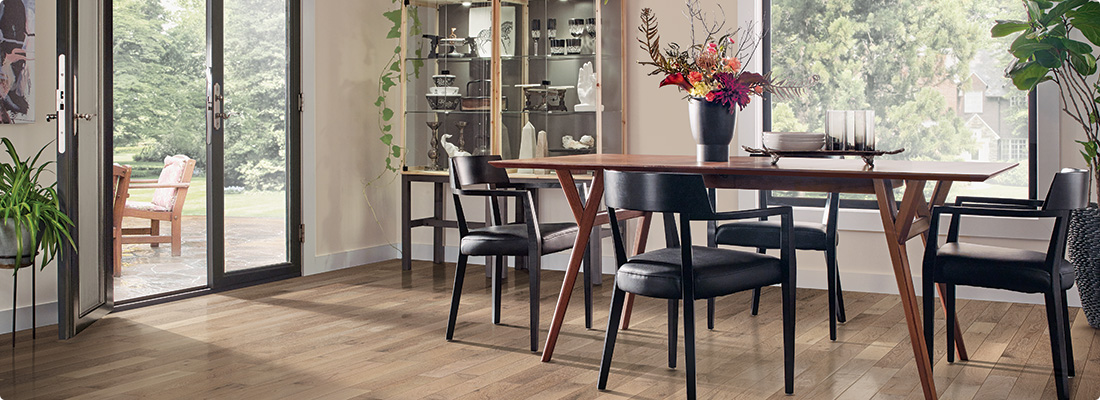
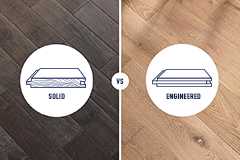 Solid vs Engineered Hardwood Flooring
Solid vs Engineered Hardwood Flooring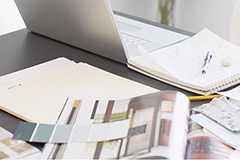 Guide To Choosing a Hardwood Floor
Guide To Choosing a Hardwood Floor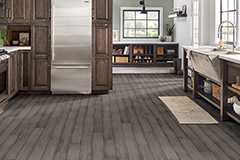 Hardwood Flooring Room Inspiration Guide
Hardwood Flooring Room Inspiration Guide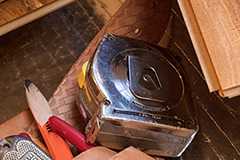 10 Things to Know About Hardwood Floor Installation
10 Things to Know About Hardwood Floor Installation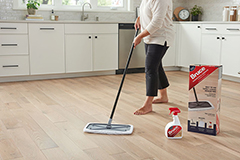 How To Clean and Protect Hardwood Flooring
How To Clean and Protect Hardwood Flooring